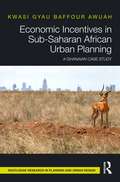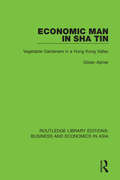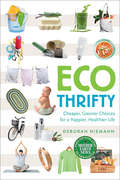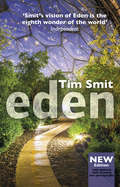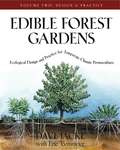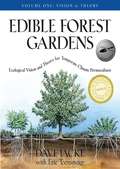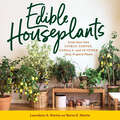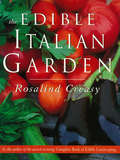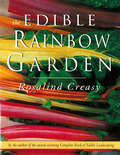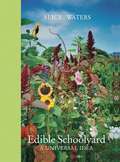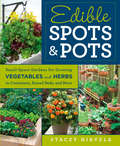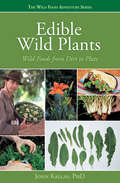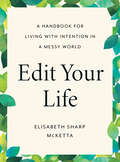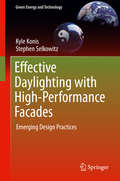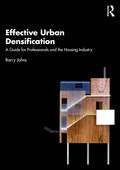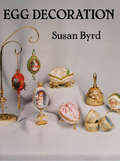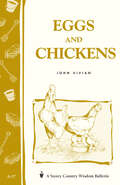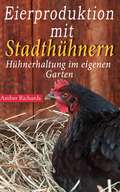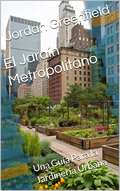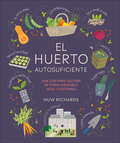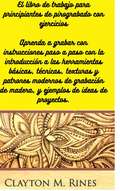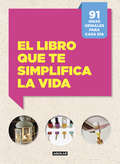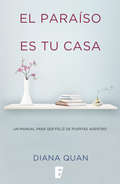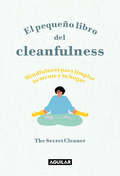- Table View
- List View
Economic Incentives in Sub-Saharan African Urban Planning: A Ghanaian Case Study
by Kwasi Gyau Baffour AwuahThis book explores incentives capable of enhancing the effectiveness of urban planning systems in Sub-Saharan Africa using economic theory as a framework. It argues that urban planning is fundamental to the achievement of sustainable and resilient cities, but against the backdrop of rising levels of urbanisation and growth, poverty, informal development, and climate change, such systems are failing to be promoted and successfully maintained in the region. Across ten chapters, it analyses the connection between urban planning and socio-economic development, indicators of effective urban planning systems, and the role and influence of incentives with real-world evidence. It develops quantitative models to estimate the costs and benefits of urban planning systems, focussing on the developing world where organised data is less accessible. Using Ghana as a case study, it demonstrates a step-by-step approach on how to implement the quantitative models discussed. Economic Incentives in Sub-Saharan African Urban Planning will be useful reading for researchers, policy-makers, development agencies, and students in urban planning, sustainable development, and economics.
Economic Man in Sha Tin: Vegetable Gardeners in a Hong Kong Valley (Routledge Library Editions: Business and Economics in Asia #11)
by Göran AijmerThis book, first published in 1980, is a study of how refugee immigrants from China make a living as market gardeners in a valley in Hong Kong. Based on extensive field-work, it examines various aspects of economic life; the discussion concerns the adaptations necessitated on the part of the gardeners by the new socio-economic structures which present themselves. The general problem of agricultural change is discussed and the Hong Kong observations are systematized into a comparative Chinese framework.
Ecothrifty: Cheaper, Greener Choices for a Happier, Healthier Life (Mother Earth News Books for Wiser Living)
by Deborah NiemannA guide to saving a fortune while saving the Earth, from the author of Homegrown & Handmade. Use it up, wear it out, make it do, or do without. Our grandmothers knew the importance of responsible, thrifty choices. But somewhere along the way we lost our way and succumbed to the belief that we can get everything for next to nothing, have it shipped halfway around the world and then—more often than not—just throw it away. This consumer binge is taking its toll. Diet and lifestyle-related illnesses are epidemic, our environment is awash in a sea of plastic, our climate is changing, and the cost of everything is skyrocketing with the price of oil. Are we doomed? No. We can make greener, healthier choices, and we can do it while saving money. Where to start? Ecothrifty is packed with simple, practical ideas and recipes to help you:· Make homemade products for cleaning and skin care · Grow your own food and cook more from scratch · Raise your family without lowering your standards A must-read for anyone who has ever wanted to live a greener life but thought that it would be too expensive, time-consuming, or difficult, this handy, complete guide will show you how small changes can have a huge environmental impact and save you thousands of dollars, all while improving your quality of life.&“I support and endorse this wonderful book, 100%!&” —Ed Begley, Jr., actor and environmentalist&“Her advice does not come across as self-righteous or preachy, but more like insider tips from an experienced do-it-yourselfer.&” —Publishers Weekly
Eden: Updated 15th Anniversary Edition
by Tim Smit'Smit's vision of Eden is the eighth wonder of the world' Independent'Inspiring... An invaluable guide to how a large project can exceed against all odds' The Sunday Times-An updated edition of the bestselling story of the Eden Project featuring stunning new photography.At the beginning of the twenty-first century, the impossible was delivered. From the sterile depths of a disused china clay pit in Cornwall rose one of the most remarkable and ambitious ventures in recent memory. The Eden Project's Biomes, the world's largest conservatories, are the symbol of a living theatre of plants and people and their interdependence, of regeneration and of a pioneering forum for the exploration of possible futures.This is the extraordinary story of the Eden Project, of its conception, design and construction, of the larger-than-life personalities who made it happen and of all that has happened since its doors were first opened to the public in 2001. It is now undisputedly one of the world's great gardens with more than 17 million visitors flocking there and projects and partnerships all over the world.
Edible Forest Gardens: Ecological Design And Practice For Temperate Climate Permaculture (Volume #2)
by Eric Toensmeier Dave JackeIn Volume II, Dave Jacke and Eric Toensmeier move on to practical considerations: concrete ways to design, establish, and maintain your own forest garden. Along the way they present case studies and examples, as well as tables, illustrations, and a uniquely valuable "plant matrix" that lists hundreds of the best edible and useful species.
Edible Forest Gardens: Ecological Vision And Theory For Temperate Climate Permaculture Volume 1
by Eric Toensmeier Dave JackeEdible Forest Gardens is a groundbreaking two-volume work that spells out and explores the key concepts of forest ecology and applies them to the needs of natural gardeners in temperate climates. Volume I lays out the vision of the forest garden and explains the basic ecological principles that make it work.
Edible Houseplants: Grow Your Own Citrus, Coffee, Vanilla, and 43 Other Tasty Tropical Plants
by Byron E. Martin Laurelynn G. MartinThe world of houseplants just got tastier with this colorful guide to growing edible plants indoors! Houseplant enthusiasts will be delighted to discover the range of tropical plants that can be grown in containers indoors, in any location. Laurelynn and Byron Martin, owners of Logee's Plants for Home & Garden, are nationally renowned for their expertise in growing fruit-bearing and tropical plants indoors. Their colorful guide features photos and complete care guidelines for 46 food-bearing plants, includes lemons, limes, grapefruit, cherries, olives, passion fruit, papaya, and much more. Fresh, fragrant, and flavorful, Edible Houseplants expands the fun and pleasure of growing indoor plants.
Edible Italian Garden
by Rosalind CreasyCreasy offers recommendations for selecting and growing the best varieties ofItalian herbs and vegetables: basil, broccoli rabe, fava beans, and tomatoes. Over 90 color illustrations.
Edible Rainbow Garden
by Rosalind CreasyWith gorgeous, four-color photographs, and simple yet authoritative text, award-winning author Rosalind Creasy offers four new volumes in her popular Edible Garden series, each featuring helpful hints, expert gardening techniques, delicious recipes, and interviews with master gardeners and renowned chefs. Purple potatoes and cream-colored tomatoes are just two of the delightful things to grow in a rainbow-colored garden. Here, Ros tells readers how to bring all the colors of the rainbow into their garden and onto their plate -- for a most delicious and colorful eating experience.
Edible Schoolyard: A Universal Idea
by Alice Waters David Liittschwager Daniel DuaneOne of America's most influential chefs, Alice Waters created a revolution in 1971 when she introduced local, organic fare at her Berkeley, California, restaurant, Chez Panisse. Twenty-five years later, she and a small group of teachers and volunteers turned over long-abandoned soil at an urban middle school in Berkeley and planted the Edible Schoolyard. The schoolyard has since grown into a universal idea of Edible Education that integrates academics with growing, cooking, and sharing wholesome, delicious food. With inspiring images of the garden and kitchen and their young caretakers. Edible Schoolyard is at once a visionary model for sustainable farming and childhood nutrition, and a call to action for schools across the country.
Edible Spots and Pots: Small-Space Gardens for Growing Vegetables and Herbs in Containers, Raised Beds, and More
by Stacey HirvelaIt's time for home gardeners to rethink the traditional garden and explore the wide variety of options for growing edibles in "anywhere" gardens—from decorative pots and raised beds to unusual growing bags, hanging pouches, and tomato rings. These contained gardens are more manageable than long rows or plots and require much less work—yet yield just as much bounty.Featuring dozens of preplanned planting recipes, based on space or container sizes, Edible Spots and Pots allows readers to mix and match vegetables, herbs, small fruits, and edible flowers to create a plant-style patchwork based on the "thriller" (dramatic, focal-point plants), "filler" (midheight, bushy plants), and "spiller" (vines and twining plants) formula for creating interesting and botanically sound gardens. Plot-free gardening offers practical solutions for any circumstance a gardener may encounter (challenging spaces, soils, or weather), while also taking into account budget, time, and aesthetic goals.Author Stacey Hirvela shares many other interesting concepts, like One-Minute Veggies (foods that go from patio to plate in less than a minute) Doubly Delicious Crops that give two flavors from one plant, and space/yield ratios (vegetables worth their footprint). Gardeners will also find an enticing array of 60 edibles that grow well in a defined space for productivity and beauty.
Edible Wild Plants: Wild Foods From Dirt To Plate (The\wild Food Adventure Ser.)
by John KallasThe founder of Wild Food Adventures presents the definitive, fully illustrated guide to foraging and preparing wild edible greens.Beyond the confines of our well-tended vegetable gardens, there is a wide variety of fresh foods growing in our yards, neighborhoods, or local woods. All that&’s needed to take advantage of this wild bounty is a little knowledge and a sense of adventure. In Edible Wild Plants, wild foods expert John Kallas covers easy-to-identify plants commonly found across North America. The extensive information on each plant includes a full pictorial guide, recipes, and more.This volume covers four types of wild greens:Foundation Greens: wild spinach, chickweed, mallow, and purslaneTart Greens: curlydock, sheep sorrel, and wood sorrelPungent Greens: wild mustard, wintercress, garlic mustard, and shepherd&’s purseBitter Greens: dandelion, cat&’s ear, sow thistle, and nipplewort
Edit Your Life: A Handbook for Living with Intention in a Messy World
by Elisabeth Sharp McKettaAn inspiring guide to focusing on what matters most in life—and hitting delete on what doesn&’t. Life is noisier, messier, and more complicated than ever. In our quest to keep up, we can lose sight of what we care about most, and instead try to do it all—with mixed results. In this beautiful call to examine and edit our lives, writer Elisabeth Sharp McKetta shares eight simple ways to cut through the clutter, drama, and overwhelm of modern life to live with more intention and joy. Inspired by her own experiments with reprioritizing, tiny house living, and finding the right balance of work and family time, Edit Your Life brings together personal narrative and practical takeaway, with inspiring results. Whether you&’re pivoting, downsizing, relocating, or just ready to have more time and energy for the people and activities you love most, this engaging and practical guide will bring you on a journey of exploration and reflection—and point you toward the life you truly want to live.
Effective Daylighting with High-Performance Facades
by Stephen Selkowitz Kyle KonisThe book explores advanced building-facade daylighting design practices based on diverse energy and human-factor performance metrics. It also defines effective daylighting by rethinking the simplified approach to glazing and facade systems to incorporate the local climate and the needs of building occupants as critical drivers of building performance, design solutions and technological innovation. It discusses state-of-the-art approaches in the context of simulation-based design workflows, innovative technologies and real project case studies, all targeting low and net-zero energy solutions that enhance occupant comfort. Readers benefit from a comprehensive approach that improves the feedback loop between design intent and performance in use. The book is intended for architects, lighting designers, facade engineers, manufacturers and building owners/operators, as well as advanced students.
Effective Urban Densification: A Guide for Professionals and the Housing Industry
by Barry JohnsThe housing crisis confronts two of North America’s contemporary urban challenges: affordability and the need to curtail urban sprawl through densification of existing communities. Advancing a novel formula labelled BAAKFIL, this book introduces a new way of thinking about affordability and revitalization of mature neighbourhoods and communities. Beginning with an exploration of the monoculture of homogenous, average quality suburban housing stock in North America, subsequent chapters explore the serious issue of land cost; infill, zoning and Nimbyism in the context of the mass housing industry. Then, bridging the gap between theory and practice, the author introduces a theoretical design approach (BAAKFIL) as a practical formula for adding affordable residential units in established single family neighbourhoods while respecting their defining features. The final chapters evaluate the efficacy of BAAKFIL as a conceptual model by exploring various ‘test bed’ sites where the framework is applied. This book will be a valuable resource for practicing architects in the housing domain, as well as for planners working in municipalities. It will also appeal to advanced undergraduate and postgraduate students of urban design and architecture.
Egg Decoration
by Susan ByrdIf you are looking for a new form of expression, a new canvas on which to apply your talents, egg decoration could very well be for you. Egg decoration is a time-honored art that was part of the future of ancient China, flourished over the centuries in the course of the European kings, and inspired the rare artistry of famed Russian goldsmith Peter Carl Fabergé. It is an art you can master, and Susan Byrd will show you how, step by step, in this superb guide to every phase of traditional egg decoration.Over 70 illustrations and easy-to-follow instructions will guide you through these eight progressively more complex projects. Among them are such exquisite items as a silk-lined jewel box, delicate musical bell, lace-trimmed "cradle," lovely decoupaged napkin rings, and four other beautiful projects. Along the way you will learn the many types of eggs suitable for decorating; how to choose appropriate tools and glues; how to empty, mark, cut, and hinge an egg; and how to paint, sand, and apply decoupage. You will even learn the history of egg decorating.Best of all you will have been introduced to an exciting and rewarding hobby that will provide hours of enjoyment and personal satisfaction.
Eggs and Chickens: Storey's Country Wisdom Bulletin A-17 (Storey Country Wisdom Bulletin Ser.)
by John VivianSince 1973, Storey's Country Wisdom Bulletins have offered practical, hands-on instructions designed to help readers master dozens of country living skills quickly and easily. There are now more than 170 titles in this series, and their remarkable popularity reflects the common desire of country and city dwellers alike to cultivate personal independence in everyday life.
Eierproduktion mit Stadthühnern
by Amber Richards Beatrice RueckertMeinen Sie, man müsste auf dem Land leben oder einen Bauernhof haben, um Hühner zu halten? Meinen Sie wirklich? Hühnerhaltung in der Stadt ist immer weiter verbreitet und die Vorteile sind bemerkenswert. Falls Sie glauben, daß Hühner viel Arbeit machen und es einfacher ist, mal schnell im Laden um die Ecke ein Dutzend Eier zu kaufen, dann haben wir Neuigkeiten für Sie. Eierproduktion mit Stadthühnern: Hühnerhaltung im eigenen Garten beendet das Rätselraten. Dieses Buch hat Antworten auf die häufigsten Fragen, erklärt den Weg zur eigenen Hühnerschar und versorgt Sie mit dem Wissen, das Sie brauchen um richtig loszulegen. Ihre Familie mit frischen Bio-Eiern zu versorgen, ist eine Leichtigkeit. Zu wissen, wo Ihre Eier herkommen und wie sie erzeugt wurden, ist heutzutage von unschätzbarem Wert. Schauen Sie mal rein: Gründe für die Hühnerhaltung Bevor es losgeht mit der Hühnerschar Welche Hühnerrassen kommen in Frage? Woher bekommt man Hühner? Mit oder ohne Hahn? Einen Hühnerstall errichten Wieviele Hühner benötigt man? Hühner mit Futter und Wasser versorgen Hühner gesund halten Wichtige Gesundheitsvorsorge in der Hühnerhaltung Einsammeln und Säubern von Hühnereiern Sich um Hühner zu kümmern ist ein lehrreiches 4H-Projekt für Kinder. Gefiederte Freunde haben einen großartigen Charakter, lehren Verantwortung und bringen die Familie zusammen. Wenn Sie über Hühnerhaltung nachdenken, sind Sie hier richtig.
El Jardín Metropolitano: Una guía para la jardinería urbana
by Jordan GreenfieldEn el ajetreo de la vida urbana, donde la belleza de la naturaleza es ocultada por toneladas de cemento, la idea de practicar jardinería parece ser un sueño lejano. Sin embargo, la importancia de los jardines en áreas urbanas no debe ser relegada pues a medida que las ciudades crecen y la población aumenta, la necesidad de contar con espacios verdes se vuelve más acuciante. La jardinería ofrece un refugio en medio del caos, proporcionando no sólo una fuente de alimentos frescos, sino también la oportunidad de reconectar con la naturaleza, promover el bienestar mental y fomentar actividades comunitarias.
El Libro de las flores y los árboles (DK Our World in Pictures)
by DKEmprende un emocionante viaje por las maravillas del reino de las plantas a través de más de 1000 imágenes y aprende un montón de datos fascinantes. ¿Qué plantas comen insectos? ¿Cómo almacenan agua los cáctus? ¿Qué flor se parece a una abeja? ¿Dónde está el árbol más alto del mundo? Los niños encontrarán las respuestas a estas y muchas más preguntas sobre la naturaleza en El libro de las flores y los árboles, ¡un increíble recorrido por el misterioso mundo de los árboles, las flores, las hojas y las semillas!Este libro de plantas para niños, incluye:Toda la información sobre la vida de las plantas, como los hábitats en los que crecen o los alimentos que nos proporcionan.Fotografías e imágenes desde diferentes perspectivas de cada tipo de planta (árboles, hierbas, plantas con flores).Lenguaje sencillo y fácil de entender para niños y niñas en edades comprendidas entre los 7 y 12 años.Especies de plantas peculiares, desconocidas y muy divertidas: árboles con frutos tan grandes como el dedo de un gigante, orquídeas que parecen caras de mono, semillas que giran como helicópteros ¡y árboles que gotean veneno!Desde las semillas más pequeñas y los árboles más altos hasta flores extrañas, malolientes y mortíferas, ¡apréndelo todo sobre el reino vegetal y diviértete leyendo este libro de plantas para niños con tus hijos! El regalo perfecto para pequeños lectores que sienten curiosidad por aprender sobre ciencia y naturaleza.---------------------------Packed with more than 1,000 incredible images and fascinating facts, this beautiful children's book takes you on an exciting expedition through the wonders of the plant kingdom.Explore the incredible world of plants, from the smallest seeds to the tallest trees. Find out about the weirdest, smelliest, and deadliest flowers. Which plants eat insects? How do cacti store water? What flower looks like a bee? Where is the tallest tree in the world? Trees, Leaves, Flowers & Seeds explores the mysterious world of plants to find the answers to these and many more questions in Our World in Pictures: Trees, Leaves, Flowers and Seeds. Each type of plant - such as a flowering plant, a tree, a grass, or a cactus - is examined close-up, with examples shown from all angles and cross-sections. Picture-filled galleries also show the wonderful variety of plants on different themes, from the habitats they grow to the plants that supply us with our staple foods. But Trees, Leaves, Flowers & Seeds also takes a fun, more sideways look at some extraordinary plants, such as trees with fruits like a giant's fingers, orchids that look like monkey faces, seeds that spin like helicopters, and trees that drip poison.So open this fantastic book and learn more about the world of trees, leaves, flowers, and seeds.
El huerto autosuficiente (Grow Food for Free)
by Huw Richards¿Te gustaría cultivar tus propias verduras, frutas y hortalizas con coste cero?Huw Richards logró autoabastecerse de la comida de su propio huerto durante todo un año y ¡tú también puedes! Pasa las páginas de este completo manual de horticultura y aprende todo lo que necesitas saber para cultivar y recolectar tus propios alimentos de manera autosuficiente y ecológica.Sea cual sea el espacio con el que cuentes o la experiencia que tengas, este guía de cultivo te enseña cómo hacer un huerto en casa de forma fácil:Consejos para elegir el lugar y el sistema de cultivo más adecuados: el jardín, el balcón, una azotea o terraza, en el suelo, en camas elevadas, en contenedores…Información sobre las herramientas de jardinería y los materiales que necesitas.Cómo preparar y sembrar la tierra, hacer compost, eliminar malezas, plagas y enfermedades, conseguir semillas.Fichas de cultivo de más de 30 tipos de plantas, populares y perennes.Incluye un diario de cultivo de 54 semanas donde Huw Richards explica cómo cultivó sus propios alimentos durante todo un año sin gastar nada de dinero.Consejos sobre cómo vender tu cosecha y conseguir dinero para agrandar la zona de cultivo.El libro de jardinería perfecto para todo aquel que desee iniciarse en el arte del huerto urbano y cultivar sus propios alimentos orgánicos y saludables.--------------------------------------------Zero-cost, low effort and a long term solution to your fresh produce needs!Huw Richards set himself a challenge - to be self-sufficient by growing his own fruit and veg for free for a year. He succeeded, and now wants to help you do the same.Grow your own food in your home garden, allotment or container and look forward to a bountiful harvest year-round. You can plant fruit and veg at home without spending a penny and Huw Richard's shows you how.Packed with tried-and-tested advice, this gardening book covers:Finding a space to grow - in the garden or on a terrace or balcony - and sourcing the materials you needDeciding what to grow your crops in (the ground, a raised bed, or containers)Clear growing instructions on more than 30 species of popular annual and perennial cropsHuw Richards' 52-week journal of how he grew his own food for free for a year without spending a pennyAdvice on how to go about selling your produce to raise money to expand your growing areaLearn about the space you need and how to prepare it, make your own compost, tackle weeds, pests, and diseases, and how to get hold of your first set of seeds! Discover many strategies to expand your garden for the better.
El libro de trabajo para principiantes de pirograbado con ejercicios
by Clayton M. RinesEl arte del pirograbado, también conocido como pur graphos (escritura a fuego), es tan antiguo como la humanidad, y esta forma de arte da una inconmensurable satisfacción a los artistas al dar poder a la imaginación. Este libro ofrece una nueva perspectiva, mostrando todo lo necesario para comenzar su viaje con este arte atemporal. En El libro de ejercicios para principiantes de pirograbado, Clayton M. Rines le muestra los conceptos básicos de la escritura grabada, tipos de puntas, lápices, técnicas de sombreado y otros métodos menos conocidos que le ayudan a desarrollar su arte. Aprenderá los pormenores de la compra de su primer pirograbador, los tipos de madera que se deben grabar, los consejos de seguridad, el mantenimiento de la sala de trabajo y otros consejos esenciales para que los proyectos de grabación en madera tengan éxito. Este libro le ofrece algunos proyectos fáciles de llevar a cabo como una forma de acostumbrarse al arte de grabar en madera, desde la fabricación de relojes de pared, porta llaves hasta la creación de posavasos y brazaletes con imágenes. Usted aprenderá: Proyectos fáciles para todos, aprenderá a escribir, sombrear y aplicar esquemas, la importancia de los ajustes de temperatura, saber qué tipo de plumas para grabar usar, consejos importantes de seguridad, conocer las técnicas de textura y acabado, grabar esos grandes regalos para sus seres queridos, ¡y mucho más! Con el libro de ejercicios para principiantes de pirograbado, usted está en camino de convertirse en un profesional del grabado en madera, placas de madera, artículos para el hogar y mucho más. Tome una copia hoy y comience su viaje de pirograbado
El libro que te simplifica la vida
by Sandro Russo Letizia CafassoUn pequeño libro con grandes ideas para hacerte la vida más fácil. ¿Alguna vez has necesitado amplificar la señal de tu wi-fi y no has sabido cómo? ¿Sabes cómo puedes aprovechar hasta la última gota de los tubos de crema? ¿Es un engorro ponerte ese vestido con cremallera trasera porque nunca consigues abrochártelo sola? ¿Has tenido una cita que se ha ido al traste por no poder abrir una botella de vino o porque no estuviera suficientemente frío? ¿Has tenido que tirar tu CD favorito porque se había rallado? Para los despistados, para los caseros, para los que viven cada día sin pensárselo demasiado, para los ecológicos y para los manitas... Para resolver todas tus pequeñas crisis diarias con mucha imaginación y objetos que todos tenemos a mano, llega El libro que te simplifica la vida, un pequeño compendio de ideas fáciles y gratuitas para hacerte la vida más fácil en casa y en cualquier lugar.
El paraíso es tu casa: Un manual para ser feliz de puertas adentro
by Diana QuanNo hay nada como el hogar. De nosotros depende que sea como queremos. Y si bien es cierto que inevitablemente acaba siendo una manifestación de nuestra personalidad, también lo es que con una preparación adecuada, una estrategia relativa a los objetivos claros, tenacidad, rigor y buena voluntad, podemos cambiar el estilo del lugar donde vivimos. Y, al mismo tiempo, nos cambiaremos también un poco a nosotros mismos. De hecho, no hay ninguna transformación que introduzcamos en nuestro entorno que no nos afecte de manera directa, así como a nuestras actividades cotidianas. Este libro habla precisamente de todo esto y de mucho más. Concebido como una guía, encontraremos en él información para saber qué dice de nosotros nuestro hogar; orientación sobre los cambios que podemos hacer para transformarlo a fin de obtener el mayor bienestar; las características de cada estancia para saber cuáles generan vitalidad, relax o concentración e inspiración; consejos para sanar o mejorar nuestro estado de ánimo a través del sitio en que vivimos, con elementos tan sencillos como la luz, las plantas y los colores; técnicas para conseguir llenar de positividad nuestra vivienda; detalles prácticos sobre los mejores materiales para crear un hogar saludable; ideas para conseguir que en él reinen siempre la armonía y la tranquilidad.
El pequeño libro del Cleanfulness: ¡Mindfulness para limpiar tu mente y tu hogar!
by The Secret CleanerLimpiar puede ser una actividad sencilla y divertida (¡sí, en serio!). Descubre el cleanfulness, la unión perfecta entre el mindfulness y el cuidado del hogar. Si tenemos que pasar más tiempo en casa, disfrutemos de ella y convirtamos el ritual de su limpieza y cuidado en un momento de alegría y relajación. El Cleanfulness es la sensación de paz y bienestar que uno consigue realizando las tareas del hogar. Organiza tu casa en poco tiempo y con un esfuerzo mínimo, reduce el consumo y la acumulación de objetos y productos de limpieza, almacena las cosas de manera práctica y eficiente y descubre cómo elaborar tú mismo productos naturales, ecológicos y libres de crueldad animal. Con los sencillos y rápidos consejos este libro conseguirás que la limpieza y el orden se conviertan en actividades placenteras y divertidas para toda la familia; en especial para los niños, que crecerán en un entorno cuidado, creado y conservado por ellos mismos. Los lectores comentan...«Un librito fantástico (lo leí de un tirón). Lleno de sentido común». «Libro de tamaño perfecto con todo lo que necesitas saber de Secret Cleaner, una mujer inteligente, a quien sigo en instragram. Una gran pequeña compra». «Me encanta este librito, lo leí en aproximadamente una hora, pero está lleno de sugerencias y consejos inspiradores que me han resultado muy útiles. Me ha dado una perspectiva diferente sobre cómo abordo mi rutina de limpieza».
